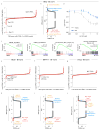Sensitivity and engineered resistance of myeloid leukemia cells to BRD9 inhibition
- PMID: 27376689
- PMCID: PMC4990482
- DOI: 10.1038/nchembio.2115
Sensitivity and engineered resistance of myeloid leukemia cells to BRD9 inhibition
Abstract
Here we show that acute myeloid leukemia (AML) cells require the BRD9 subunit of the SWI-SNF chromatin-remodeling complex to sustain MYC transcription, rapid cell proliferation and a block in differentiation. Based on these observations, we derived small-molecule inhibitors of the BRD9 bromodomain that selectively suppress the proliferation of mouse and human AML cell lines. To establish these effects as on-target, we engineered a bromodomain-swap allele of BRD9 that retains functionality despite a radically altered bromodomain pocket. Expression of this allele in AML cells confers resistance to the antiproliferative effects of our compound series, thus establishing BRD9 as the relevant cellular target. Furthermore, we used an analogous domain-swap strategy to generate an inhibitor-resistant allele of EZH2. To our knowledge, our study provides the first evidence for a role of BRD9 in cancer and reveals a simple genetic strategy for constructing resistance alleles to demonstrate on-target activity of chemical probes in cells.
Conflict of interest statement
This study was funded in part via a sponsored research agreement with Boerhinger Ingelheim.
Figures






Comment in
-
Target validation: Switching domains.Nat Chem Biol. 2016 Aug 18;12(9):659-60. doi: 10.1038/nchembio.2154. Nat Chem Biol. 2016. PMID: 27538023 No abstract available.
References
Publication types
MeSH terms
Substances
Associated data
- PubChem-Substance/313633329
- PubChem-Substance/313633330
- PubChem-Substance/313633331
- PubChem-Substance/313633332
- PubChem-Substance/313633333
- PubChem-Substance/313633334
- PubChem-Substance/313633335
- PubChem-Substance/313633336
- PubChem-Substance/313633337
- PubChem-Substance/313633338
- PubChem-Substance/313633339
- PubChem-Substance/313633340
Grants and funding
LinkOut - more resources
Full Text Sources
Other Literature Sources
Medical
Molecular Biology Databases
Research Materials

